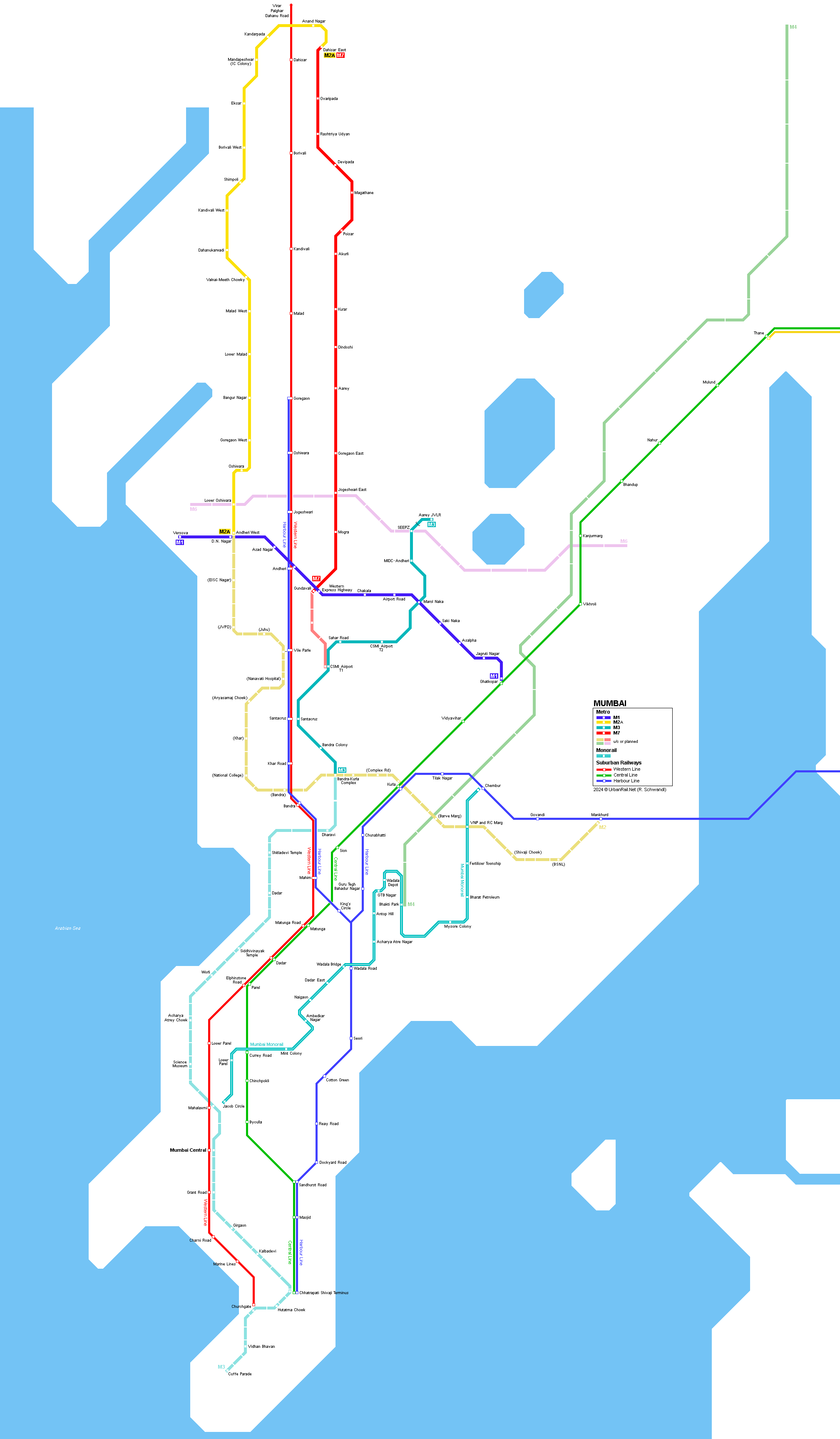
|
[ UrbanRail.Net ] [ Europe ] [ Americas ] [ Asia ] [ Africa ] [ Oceania ] [ News ] [ Books ] [ Links ] |
|
MUMBAI
|
| Maharashtra . India |
Click on map to expand to full size Greater Mumbai Rail Map!
| METRO | |
|
Mumbai (formerly Bombay, approx. 12 million inh., some 20 million in metropolitan area) Besides the busy suburban railways, which radiate from two termini in the city centre, Mumbai is developing a modern rapid transit system although at a pace much below that of Delhi. The first metro line eventually started service in spring 2014, a few months after the first section of a monorail line had been brought into service. |
|
| Metro Line 1 - Blue Line | |
|
08 June 2014: Versova - Andheri - Ghatkopar - 11.5 km, 12 stations, all elevated
|
|
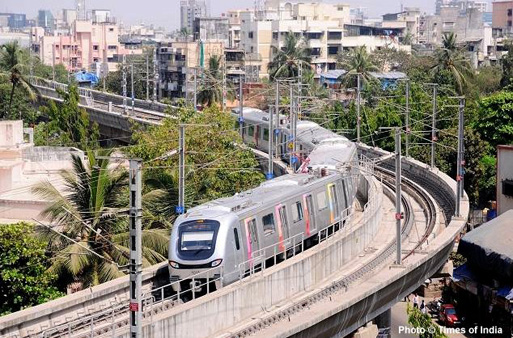
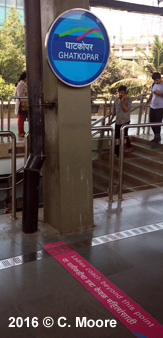
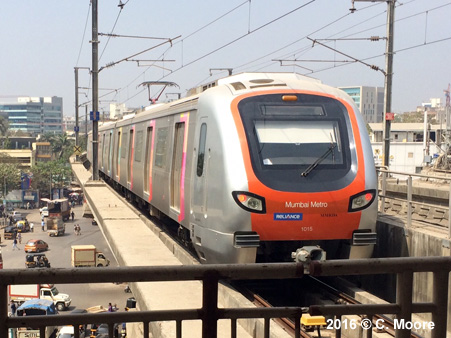
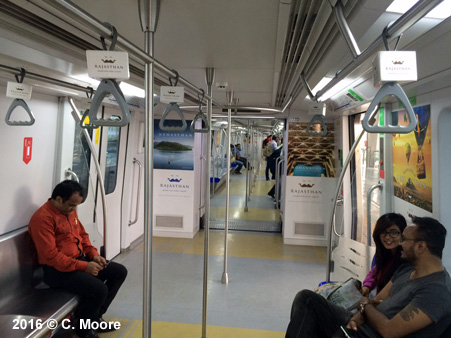
|
|
| Metro Line 2 -Yellow Line | |
|
- initially operated as line 2A jointly with line 7: 02
Apr 2022: Dahanukarwadi – Dahisar East (8.9 km) - initially operated as line 2B: ~ Dec 2025: Diamond Chowk – Mandale (5.4 km)
|
|
| Metro Line 3 - Aqua Line | |
|
33.5 km north-south line, mostly underground 07
Oct 2024: Aarey JVLR – Bandra-Kurla Complex (12.7 km)
|
|
| Metro Line 7 - Red Line | |
|
02
Apr 2022: Dahisar East – Aarey (9.5 km) - initially operated jointly with line 2A
|
|
|
Metro Projects |
|
|
For details on Mumbai Metro projects, see MMRDA's Project Website and Wikipedia here ! Navi Mumbai, located on the eastern side of Mumbai metropolitan area, is in the process of developing its own first elevated metro line. The line is being built in three phases (from 2011 to around 2016 or 2017): Phase
1: Belapur-Kharghar-Taloja-Pendhar; 11.10 km, 11 stations
|
|
|
|
|
| MUMBAI MONORAIL | |
|
02-02-2014:
Wadala Depot - Chembur (9 km) |
|
|
|
|
| SUBURBAN RAILWAYS | |
|
The major sections of the exclusive MRTS system are (not including those shared with long distance trains) a. Churchgate to Borivali on the Western Railway (WR) - 34 Km. A further 26 Km on this line from Borivali to Virar has regular suburban trains running on the main line tracks (shared with long distance trains). The separate line from Borivali to Virar is under construction. b. Mumbai CST to Kalyan on the Central Railway (CR) Main Line (54 Km). Further, there are regular suburban trains going further and using the main line tracks (shared with long-distance trains). The two different lines from Kalyan onwards are Kalyan to Karjat (61 Km) and Kalyan to Kasara (67 Km). c. Mumbai CST to Panvel on the Harbour Line (CR) (50 Km) d. Wadala to Andheri linking the Harbour Line to the Western Railway Corridor.(11 Km) 24 Aug 2004: Thane - Vashi (22km) |
|
| Links | |
|
Mumbai Railway Vikas Corporation Ltd Mumbai Metro One (Official Site) Mumbai Metro Rail Corporation Ltd (MMRC) - (Official Site for Line 3) Metro Projects (Government Site) Mumbai Metro (Unofficial Site) Mumbai Metro at Wikipedia Mumbai Monorail at Wikipedia Mumbai Metro Projects (TheMetroRailGuy) Mumbai Suburban Railways at Wikipedia |
|
| Report | |
|
Craig Moore reports from Mumbai in Feb 2016: Located on a small spit of land, MUMBAI is the liberal, open, ostentatious side of urban India, with a wonderful bay, unfettered development and vast extremes of wealth and deprivation. Its growth has overspilt to surrounding areas and the urban rail environment has responded to this with new developments in the north (metro) and east (monorail), although the core of rail movement remains the famous and charismatic suburban rail system. Together, the greater Mumbai area has 244km of urban rail provision, hosting 105 stations. The Mumbai Metro was opened in 2014 and is inadequate. The 11.4km service skirts the northern part of the urban area from Versova to Ghatkopar and is fully elevated with 12 large stations. The line has 1435 mm gauge and has overhead power supply, and follows the path of main arteries with stations resting above these roads, thus dominating the streetscape. The Metro has a wonderful logo of intertwined ribbons, and the overall branding is smart. From the road, stations have a smart grey cladding with station name and logo brightly illuminated. Each station has 4 exit/entrances at each corner of the station (2 on each side of the road). The mezzanine hosts the occasional ticket machine, a ticket office and ticket barriers. There are also snack bars/coffee outlets. The ticket machines are very rarely used and the queues at the ticket offices are rather chaotic. Fares are distance-based and are between 10-30 rupees (€0.15-€0.30) and there is no day pass, nor any hard copy information available. Entry is in the form of RFID tokens which are scanned on entry through the barriers and slotted on exit. Queuing/barging for a ticket, queuing to be checked by security (scan), and then queuing/barging to get through the barriers can take 5mins! The platforms are quite nice, although there is little natural light and electric lighting is limited. The platform areas can be quite dark of a night time. There is a perfunctory strip map on the platform but no map of the overall Mumbai rail network with the exception of one map near the ticket office - this has to be one of the ugliest I have seen. Electronic screens display the next train (base headway of 8mins). All the stations have side platforms and they are built for 6 cars, although currently only 4-car sets are used, with half of the first carriage cordoned off (a little rope) for women only. Services run from 0530-2330 and are always crowded. I had to wait for the third train before I got on and then I was squeezed to such an extent it was difficult to breathe. That was 24mins on the platform, waiting around – not good. The CSR stock is smart and clean with side seating and electronic strip maps above doors. There is Hindi and English audio and electronic information. CSR clearly have a template and the stock is very similar to many of the Chinese metro operations. The ride is smooth and dwell times very quick (Indians are very very efficient at boarding and alighting!). As for the 22min journey - from Versova the line climbs quite significantly towards Chakala. The Andheri station offers a connection to the suburban rail (see below). The next stretch traverses modern developments but the downhill stretch towards Ghatkopar has a very mixed urban environment, with modern high rise and mass shanty dwellings. The Ghatkopar terminus has physical interchange to the Central Line of the suburban rail network. In general, the system looks a little grubby and is not particularly user-friendly. Given its young age and the success of the Delhi, Chennai and Bengaluru systems, this was surprising. Another new addition to Mumbai’s rail environment is the Mumbai Monorail. Although accessible from Chembur on the suburban rail Harbour Line, it is quite a walk and there is no directional signage. The 8.9km line has 7 stations with a mix of island and side platforms. The stations are ‘very concrete’ with a canopied roof. Stations are well designed and have system maps, service times and adequate signage. The service, which operates from 0630 to 2200 is not very well used, and the three-car trains (one for women) and 9min base headways more than meet demand. The stock is clean and bright with seating colour-coded with the exterior colour (blue or sickly pink). There is a basic electronic strip map and audio announcements in Hindi and English. The trains travel quite slowly but the views are interesting, and where else would you get station names such as ‘Fertilizer Township’ or ’Bharat Petroleum’. The line has extensions in construction and these will bring physical integration to the suburban rail at Parel. Only then will this line be of any use. The more recent developments in Mumbai’s urban rail environment seem to be of limited worth, and they appear to act only as feeders to the suburban rail system. This is world-renowned and is truly fantastic. The system utilises 1676 mm gauge with overhead power supply and has 4 lines with the main focus on the north-south Western Line in the east (Churchgate-Dadar-Andheri (for Metro) Borivali) and the north-easterly Central Line (CST-Dadar-Kurla-Thane). The Harbour Line (CST-Kurla-Panvel) and its branch to Andheri and the THL from Panvel to Thane are less of a focus. Interchange with the Metro and Andheri is long but you simply need to follow the crowds. There are overhead walkways that lead to the suburban rail station and its 10 platforms. The ticket office is besieged by travelers and so the queues are long. Although there are electronic indicators above each platform entry ramp, these are confusing due to the complexity of the network (Up-Down-Fast-Slow-all Stops). It is worth taking time to work out and then just join the masses on the platform for the big squeeze onto the train when it arrives. Passenger numbers are immense, the ICF stock (12 cars) is tatty, and is identified by a broad coloured band on the exterior with letters exclaiming the line (eg. CL). Passengers alight and join the train whilst it is moving on the platform. Dwell times are minimal and acceleration rates are rapid. There is audio information in Hindi and English, although it is difficult to hear, but it doesn’t really matter – it's just an experience to soak up and enjoy. The system works so well. Stations along routes have a mix of side and island platforms which means passengers aren’t focused around one door. If you are at the wrong side when it’s time to alight – don’t worry – just shout and go with the flow, there will be many hundreds of you exiting at any one time. Join the crush! At the main exchange stations, the numbers moving around is incredible, and at the terminal stations of Churchgate and CST all trains arrive in single line platforms with exit and entry possible on either side. Trains empty and fill rapidly and there is a wonderful orderliness to the whole system. Trains at the terminus have a short turnaround time before they leave again, crammed full (2 mins). There are no timetables but frequencies are approx. 4mins. Stations do have electronic and audio information and trains rarely turn up on time but seem to be a uniform 2-3mins late – and so things work very smoothly. Unsurprisingly there is no hard copy information. Tickets are distance-based with most of the system at the 5-10 rupee fare (€0.07-€0.15), although as an open system most people just seem to hop on with no checks whatsoever. The stations in general are unkempt (but have the wonderful roundel), the stock is old and the journey cramped, but the whole thing functions effectively. Truly wonderful. Hanging from the side of the open doors as the trains move through the suburbs and with the volume of train movements in view is truly exhilarating. The whole experience of the suburban rail in Mumbai is one of the most thrilling experiences and more than makes up for the disappointment of the new additions to the urban rail environment in Mumbai. As a word of caution, the Times of India had an article which provided stark figures (3304!) of deaths on Mumbai’s suburban railways in 2015 (1801 crossing the tracks; 806 falling from the train being the largest). |
|
| Photos | |
|
|
|
2004 © UrbanRail.Net by Robert Schwandl.